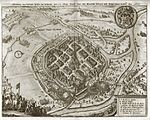Franciscan Monastery, Plzeň
Churches in PlzeňFranciscan monasteriesGothic architecture in the Czech RepublicRoman Catholic monasteries in the Czech RepublicTourist attractions in the Plzeň Region ... and 1 more
Vague or ambiguous time from March 2023

The Franciscan Monastery is located near the Main Square in Plzeň, Czech Republic. Originally belonging to the Minorites, the later Franciscan monastery was founded at the end of the 13th century. The Church of the Assumption of the Virgin Mary, Chapterhouse and Chapel of St. Barbara also belong to the monastery complex. The Franciscan church and monastery are among the city's oldest buildings and, for all the calamities of the Hussite era and Thirty Years' War, have, in essence, preserved their original early Gothic form.
Excerpt from the Wikipedia article Franciscan Monastery, Plzeň (License: CC BY-SA 3.0, Authors, Images).Franciscan Monastery, Plzeň
Františkánská, Pilsen Vnitřní Město
Geographical coordinates (GPS) Address Nearby Places Show on map
Geographical coordinates (GPS)
| Latitude | Longitude |
|---|---|
| N 49.745361111111 ° | E 13.378805555556 ° |
Address
Františkánská
301 37 Pilsen, Vnitřní Město
Southwest, Czechia
Open on Google Maps










